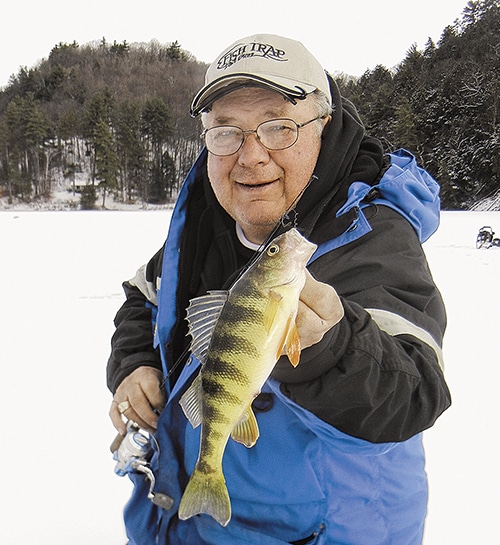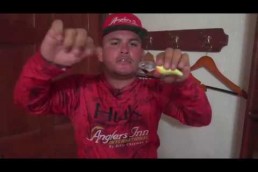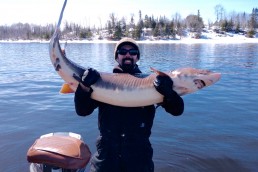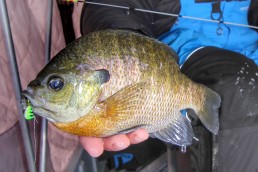Horizontal Jigs, Knot Adjustments and the Kicker
SHARE THIS POST
Since the late ‘70s, Dave Genz has been seriously fiddling with the fine points of presenting a bait to fish under the ice. The goal, always, has been to replicate that rapid, kicking, vibrating life that real prey items have.
When your presentation “has that life to it,” says Genz, “it draws fish in. It gets them in the mood to eat your bait.” The secret sauce is a rapid series of microscopic movements sent from your rod to the bait, enhanced by thin, tight line that doesn’t cushion the movements. “That jig has to respond to everything you do,” says Genz.
Of all the factors adding up to your bait going into a fish’s mouth, Genz believes that this is the most important. Since the earliest days of the ice revolution, he and his friends have been using the “Genz pound,” done by rapidly vibrating your wrist while jigging.
“We used to talk about how ‘it looks like you’re nervous’ when you’re doing it right,” he said, laughing. “The trick is to try to learn how to make movements that are short enough. You don’t want the jig to travel up and down; you just want it to look alive. You move the jig up or down by raising or lowering the rod as you pound it.”
When done to a jig that’s designed to hang in a horizontal posture, the jig’s eyelet becomes a pivot point––and the rear section of the jig ‘kicks’ up and down, sending out realistic vibrations that excite fish. Picture it in your mind: the rear section (where the hook point and live bait or plastic are) kicks up and down, like a buckin’ bronco. The jig head remains more or less in place, but vibrates rapidly in response to your fast, extremely short movements.
It’s a realistic, exciting action. One of the true keys to consistently catching fish through the ice. “That’s my go-to presentation style,” says Genz. “It’s what I start every day with. I might have to slow things down, change things up, but that’s always my starting point.”
It’s all about cadence
Several years ago, while thinking of a word to describe the fine-tuning process he goes through with his presentation each day, Genz settled on cadence. “I really want to get people to understand the importance of cadence,” he stressed. “In other words, how the bait moves. How fast it moves. What kind of feeling it gives off.”
As mentioned, he typically starts the day showing fish the Genz Pound. More often than not, it does the trick. Calls fish in, gets them to chase the bait (or at least approach close), then forces them to suck it in, to see for sure whether it’s something to eat. “And you have to keep doing it once the fish is at the bait,” urges Dave. “When the fish gets right up to the bait, that’s when most people stop doing the cadence. You have to keep it going, so they keep coming, so they keep chasing it, and grab it.”
On those days when a “hard pound” isn’t the answer, Genz experiments by slowing down the cadence.
“I’ll do that before I switch baits,” he says. “Instead of thinking you have to change (jig) color, change the cadence first. Sometimes they want it slower. But I always try to keep that ‘kick’ going, even when the cadence slows down. That’s a challenge, for sure.”
Importance of jig design
In order to produce the Genz Pound with the kick, there are several must-have features in the jig itself, and the real “kicker” that we’ll talk about in a minute.
First, the eyelet on the jig (the thing you tie the line to) has to allow the jig to adopt a horizontal posture in the water, if rigged to do so. A horizontal posture means the hook sits perpendicular to your line. This is determined by what type of hook is used, and by the ‘kicker’ we’ll talk about in a minute. (You can ‘pound’ any jig, including vertical jigs. But you can’t produce the buckin’ bronco, hook-kicking motion unless the jig is horizontally oriented.)
Genz has forever talked about the quest to find “small jigs that fish heavy for their size,” so we can get our bait down into the fish zone quickly, and back down there quickly after reeling up. It also has to do with the desire to pound the bait and maintain the feel of each cycle, so bites can be detected by noticing the feel has changed.
“But one problem we’ve always encountered,” he says, “is that, as the jig head size went down, the hooks got so tiny we had a hard time putting on more than one maggot, or wax worm, and most plastics were too big for them, too. We’ve needed small jigs that fish heavy, but with bigger hooks, that have a wide enough gap so you can put six maggots or two wax worms on there and still have enough hook to stick the fish when it bites.”

With precision, Clam declared war on the ‘small hook problem,’ releasing its XL series jigs.
“That got us going in the right direction,” notes Genz. “That, and the fact that all the jigs in the Drop series feature tungsten heads. For their size, they’re much denser, and heavier, than other jigs. That allows you to make small jigs that fishes heavy, and now we have the right hooks on them, too.”
Are you enjoying this post?
You can be among the first to get the latest info on where to go, what to use and how to use it!
Importance of knot position
Now, we come to the real “kicker” that means everything when it comes to producing the pound with the kick: knot position.
You can tie on a “horizontal” jig, but it behaves like a vertical jig because of how the knot sits on the eyelet. Or, you can swivel the knot around so it points toward the hook point, and that same jig holds a horizontal attitude in the water.
It’s a night-and-day deal.
“That’s why we’re always talking about swiveling the knot around,” says Genz, “to keep the jig horizontal. Every time you snag up on something, get a bite but don’t hook the fish, or catch a fish, the knot goes back to that vertical position.”
It has to become a habit, says Genz, “to rotate the knot back toward the hook point before putting the line back down the hole. Watching my brother, Jerry, fish this winter, he automatically adjusts his knot every time. He’s 80 years old, but many times at the end of the day, he had the best quality fish in the group. He does really well, and that’s a big part of it.”
Over the years, Dave has developed a streamlined technique for rotating the knot.
“Grab the knot between your index finger and thumb,” he says, “and rotate the rod. You don’t have to put the rod down and grab the line. The rod does the work for you, so you can do it quickly every time.”
Meaningful experimentation
We’re going to talk in detail about it later this winter, but the new frontier in Genz’s study of cadence is experimentation with knot positioning and pace of the pound.
“When you bring the knot all the way around on the eye, toward the hook point,” he says, “that gives you the most vibration. That’s the position I use most of the time. But now I’m working on what happens when you dial the knot to different positions on the eye.”
Genz long ago learned to experiment with “speed of the cadence” to find what fish want on any given day. Now, knot adjustment is bringing a new wrinkle to the testing.
Genz is excited, too, about a new jig he helped design, the Drop-Kick.
“The name gives away what this jig does,” says Dave. “The head is made from tungsten, and it’s designed to make it easy to get that kicking motion when you’re pounding. You can change the cadence, and the kick stays in there.
“We wanted the tungsten head, but we wanted to shape it in a certain way, so it shows up easily on electronics, and it behaves right in the water. And we had to make the right hook for it. Most tungsten jigs have the eye in a position that’s opposite of where the eye is on American jigs. The Drop-Kick has the eye set for maximum rotation of the knot.”
When you study the jig, you see the interesting, squarish top edges. “The larger flat surfaces give you a better sonar echo,” Genz explains. “I can see it no problem on my Vexilar, even when I turn down the gain. But we also tweaked the shape so it maintains that kicking motion, even at slower speed cadences. This is the jig I’ve wanted forever. It’s the closest thing we’ve ever made to a perfect jig for the way I like to fish.”
For more information…
Dave Genz, known as Mr. Ice Fishing, was the primary driver of the modern ice fishing revolution. He has been enshrined in the National Fresh Water Fishing Hall of Fame and Minnesota Fishing Hall of Fame for his contributions to the sport. For more fishing tips and to order his new info-packed book, Ice Revolution, go to davegenz.com.
MWO
SHARE THIS POST
Did you enjoy this post?
You can be among the first to get the latest info on where to go, what to use and how to use it!
Mark Strand
MidWest Outdoors editorial director Mark Strand is a graduate of University of Minnesota School of Journalism with a minor in Fisheries & Wildlife Science. He has written for nearly every outdoor magazine over the past 41 years, and has written or co-written 14 books. In addition to writing and photography, Strand produces the MidWest Outdoors Podcast, and contributes to MWO digital properties. He is an outdoor generalist who loves hunting and fishing of all types. In 2018 Strand was elected to the Minnesota Fishing Hall of Fame.



